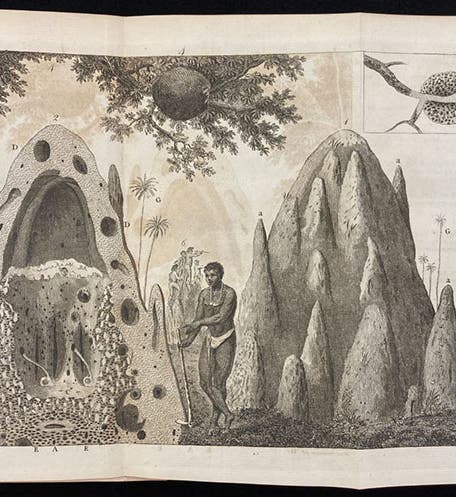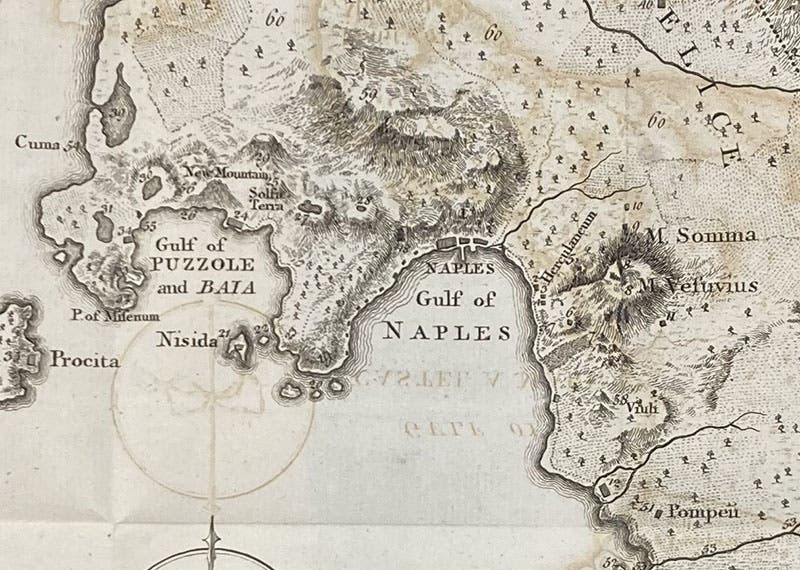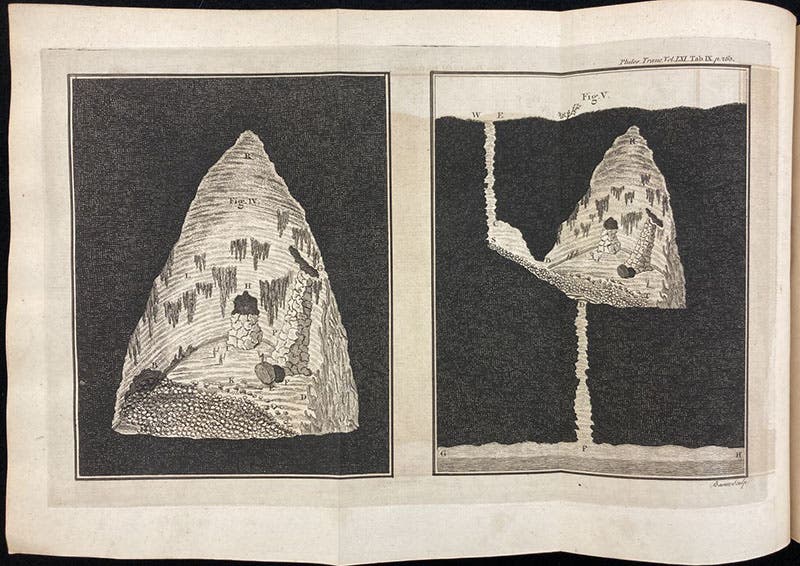Scientist of the Day - James Basire I
James Basire I, an English engraver, was born Oct. 6, 1730. His father Isaac was an engraver, and soon James took up his father's craft. I don't know what he did for the first 40 years of his life, but in 1770, he engraved a plate for the Philosophical Transactions of the Royal Society of London. The Royal Society already had an engraver, a man by the name of James Mynde, who engraved dozens of plates for the volumes up to 1770. Basire's engraving was a blockbuster, a large folding plate that showed the results of observations of the Transits of Venus of 1760 and 1769, which he did to accompany an article by Samuel Dunn (second image). This may have been the engraver’s equivalent of a screen test, and if that's what it was, Basire must have passed with high ratings, for he took Mynde's place as the unofficial (or perhaps it was official) engraver for the Philosophical Transactions. We don't know if Mynde's death in 1771 was a result of Basire's promotion, or a contributing cause. Whatever, Basire engraved most of the plates in the Philosophical Transactions for the next thirty years.
I thought I would show you a sample of Basire's work, which covered quite a range of illustrative material. If there is a list of Basire engravings for the Philosophical Transactions, I did not run across it; I found these by just pulling random volumes of the Philosophical Transactions off the shelf and leafing through them. Each volume that I perused had somewhere between a half-dozen to two dozen Basire engravings. My favorite is the drawing of termite mounds in West Africa that he did for Henry Smeathman in 1781 (first image); we showed it in our post on Smeathman, without mentioning Basire. I also like the map of the Gulf of Naples (fourth image) that he did for William Hamilton, the envoy to Naples from England and a keen observer of volcanic activity in the area; I like it because it is hard to find maps from this era that show Naples, Mount Vesuvius, and the recently unearthed Pompeii (see detail, fifth image)
I had never heard of John Lloyd or Eldon Hole, a pothole in Derbyshire, before I ran across Basire’s 1771 engravings of the site (sixth image), which are attractive because of their blackness. There are a variety of ways for an engraver to achieve a black background, using rockers to roughen the plate, or closely hatched lines, and Basire seems to have tried them all, as we see in the selections here. We also include a detail of the Eldon Hole engraving (seventh image), showing how Basire signed his work, with the simple “Basir sc.” or “Basire sculpt,” meaning “engraved by Basire.” Sometimes he added the initial “J”; usually he did not.
Basire engraved lots of animals and plants for the Philosophical Transactions, because the Fellows wrote quite a few articles about newly discovered plants and animals. The engravings are not usually too exciting, especially the plants, but I thought I would show one, a baleen whale (tenth image), that he did for the anatomist John Hunter, one of 8 engravings that were published with an article by Hunter on cetaceans in 1787. I also include one of Basire’s many instrument engravings, this one a tabletop telescope built by Edward Nairne, published in 1771 (eighth image).
Our final engraving by Basire may not impress you at first; it is an engraving of the two moons of Uranus, here called the “Georgian planet,” that he did for an article by William Herschel in the same 1787 volume that contained the baleen whale. Herschel had discovered the planet Uranus in 1781, and just a few years later, he found that his new planet had two moons. These moons were very small through the eye of Herschel’s telescope, and Basire conveyed their smallness by giving us a tiny engraving centered on an otherwise blank page (ninth image).
Basire may have done a famous engraving of Alessandro Volta’s newly invented “pile” or battery, published in 1800 – the engraving is signed “Basir sc,” and you can see it as the first image in our post on Volta. He may also have done a pair of equally famous engravings that same year, for a different journal, depicting the hand-axes of Hoxne, the first recognized prehistoric stone tools, found by John Frere. You can see both of those engravings in our post on Frere, and those too are signed “Basire.” The problem is that our James Basire had a son, James Basire II, who was also an engraver, and who succeeded his father as Royal Society engraver, and who also signed his engravings “Basire sc.” The careers of the two overlapped in the last decade of the 18th century, so it is not possible, without further evidence, which we seldom have, to determine which engraver, father or son, did an engraving in the period of overlap. After Basire I’s death in 1802, there is no longer any problem, until 1825 or so, when James Basire III, the son of Basire II, appeared on the engraving scene, and again the careers of the two younger Basires overlapped. We have already discussed both problems, in our post on James Basire II and our post on James Basire III.
We have no portraits of any of the three engravers named Basire. Such was the lot of craftsmen of that era, who were not recognized as artists – in fact, were seldom recognized at all. It is a good thing we have their engravings to remember them by.
William B. Ashworth, Jr., Consultant for the History of Science, Linda Hall Library and Associate Professor emeritus, Department of History, University of Missouri-Kansas City. Comments or corrections are welcome; please direct to ashworthw@umkc.edu.










![Two newly discovered moons of the “Georgian planet” [Uranus], engraving by James Basire I for an article by William Herschel, Philosophical Transactions of the Royal Society of London, vol. 77, plate 7, 1787 (Linda Hall Library)](https://assets-us-01.kc-usercontent.com:443/9dd25524-761a-000d-d79f-86a5086d4774/e30679e7-793e-4d23-9ac0-e2c1b6a53da3/basireI9.jpg?w=437&h=600&auto=format&q=75&fit=crop)





